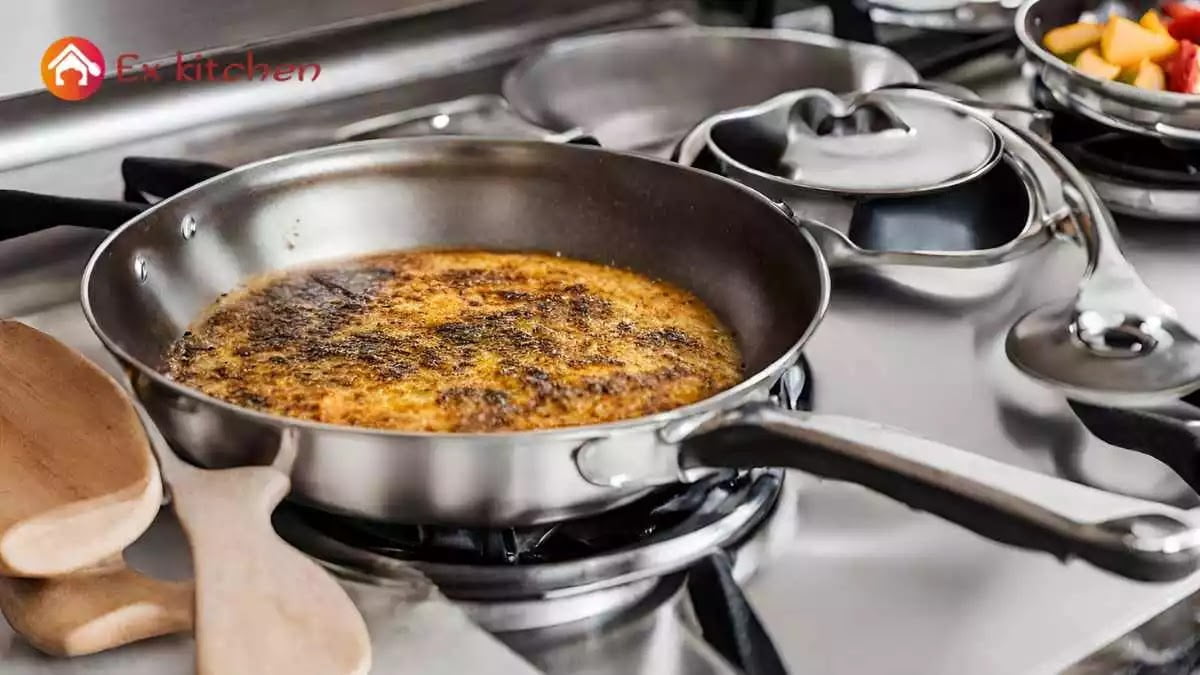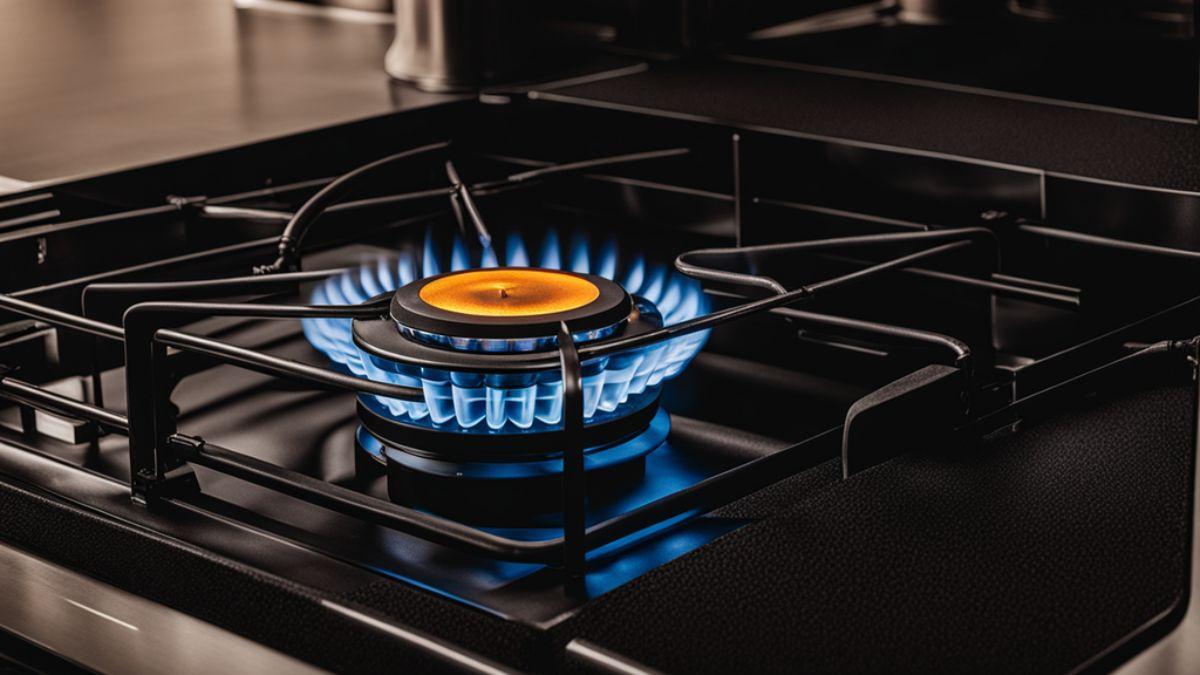
We may earn money or products from the companies mentioned in this post.
Discover the secrets to seasoning stainless steel pans and achieve effortless food release, enhanced flavor, and lasting durability. Learn the simple steps to create a natural non-stick coating that rivals traditional cookware.
Have you ever had difficulties wiping off food residue from stainless steel cookware? You do not live alone. Stainless steel is popular because it is heat-resistant and long-lasting, although it isn’t exactly renowned for not adhering. Good news! Stainless steel pans may be simply seasoned to make them naturally non-stick. You can make the most of stainless steel cookware and expand your culinary repertoire by seasoning it. Making omelets, pancakes, and other dishes that don’t cling or rip simply requires a few simple steps. The gorgeous gloss that your stainless steel cookware will get with each usage will improve the flavor of your cuisine. Learn how to make your stainless steel pans non-stick by reading on if you’re tired of struggling to get food off and want cookware that performs as well as conventional non-stick.
Why Season Stainless Steel Cookware?

If you’ve invested in high-quality stainless steel pans but find your food sticking and tearing, don’t despair. Seasoning your cookware creates a natural non-stick patina that rivals traditional non-stick coatings. By following a few simple steps, you can unleash your pans’ full potential and enjoy superior food release for years to come.
Enhanced Flavor
A well-seasoned pan allows you to use little or no oil, letting the natural flavors of ingredients shine through. The patina also subtly seasons each dish, enhancing the overall taste.
Improved Durability
Seasoning forms a protective barrier, shielding pans from water spots and stains. It helps prevent corrosion and extends the lifespan of your cookware.
Effortless Food Release
The non-stick patina makes turning and removing foods a breeze. Eggs, fish, and other delicate foods glide right out of the pan. No more scraping or stuck-on bits.
All-Natural Alternative
Unlike traditional non-stick coatings that can chip or scratch over time, seasoning provides a durable yet natural finish. Simply re-season as needed to restore the patina.
By following a few straightforward steps, you can achieve a slick non-stick surface in your stainless steel pans. Unlock their full potential and get ready for the best cooking experience of your life with seasoned cookware that’s both high-performing and healthy. Your taste buds and pans will thank you!
Debunking Myths About Stainless Steel
A lot of home cooks think stainless steel pans can’t be non-stick or that they’re hard to cook with, but that’s just not true. By seasoning your stainless steel cookware, you can achieve a natural non-stick patina and unlock this metal’s full potential.
Debunking Myth #1: Stainless Steel Isn’t Non-Stick

With proper seasoning, stainless steel can become just as non-stick as coated pans. The key is creating a layer of polymerized oil that fills in the microscopic pores and valleys in the metal. This oil barrier prevents food from sticking and creates a slick cooking surface.
Debunking Myth #2: Stainless Steel Requires a Lot of Oil
While you do need oil to season stainless steel, you only need a thin coat. Spread 1-2 teaspoons of high-heat oil like canola or flaxseed oil over the entire pan using a paper towel or lint-free cloth. Buff off any excess oil with another clean towel. More oil will not make the pan more non-stick and can lead to sticky, gummy results.
Debunking Myth #3: Stainless Steel Is Hard to Cook With

After being used for a while, stainless steel is very flexible and doesn’t need much upkeep. You can cook with less oil because the crust doesn’t stick, and it’s also easy to clean up. You can use metal tools without worrying because stainless steel is very strong and won’t hurt. Its great ability to conduct heat also makes it possible to precisely control the temperature and cook food evenly.
With the right technique, stainless steel pans can become naturally non-stick, easy to cook with, and professional grade. Seasoning your stainless steel cookware unlocks its potential and helps you become a better, more intuitive home cook. Isn’t that worth a little extra elbow grease? Your taste buds will thank you!
The Science Behind Seasoning Stainless Steel

Seasoning stainless steel pans creates a natural non-stick patina through a process called polymerization. As oil is heated, its molecules break down and re-form into larger polymer chains that bond strongly to the stainless steel surface. This coating prevents foods from sticking and makes cleanup a breeze.
The Oil
The oil you choose is critical. Flaxseed, grapeseed, canola, and rice bran oils have a high smoke point and neutral flavor, making them ideal for seasoning stainless steel. Avoid olive oil which has a low smoke point and strong flavor.
The Process
- Scrub your pan with hot, soapy water to remove any manufacturing oils. Rinse and dry completely.
- Apply a small layer of the oil of your choice to the pan. Spread the oil thoroughly over the whole pan, including the handle, with a paper towel or lint-free cloth.
- Place the pan over medium-high heat for 3 to 5 minutes until the oil starts to smoke.
- Remove from heat and let cool completely. The oil will turn a deep golden brown.
- Wipe out excess oil with a cloth or paper towel. Your pan is now seasoned and ready to use.
Food will be released effortlessly from a well-seasoned pan. However, the seasoning will continue to improve over time with regular use and additional thin coats of oil. Avoid using harsh detergents that can strip the seasoning. Simply rinse with hot water and a stiff brush. Re-season as needed if food starts to stick.
With proper care and maintenance, the natural non-stick patina on your stainless steel pan can last indefinitely. Unleash the full potential of your pans and enjoy cooking with ease! Seasoning stainless steel is a skill worth perfecting.
Choosing the Right Oil for Seasoning

Picking the right oil is very important if you want to season your stainless steel pans well. Different oils can handle the high heat needed for seasoning without going bad because they have different smoke points. Some naturally don’t stick, which helps make the perfect finish. It’s best to choose from the following:
Flaxseed oil
With one of the highest smoke points of any plant-based oil, flaxseed oil is ideal for seasoning at the high temperatures required. It’s also a “drying” oil, meaning it hardens and bonds strongly to surfaces. This allows it to create a durable, stick-resistant coating.
Coconut oil
Coconut oil has a mildly sweet flavor and natural non-stick qualities. It has a high smoke point, though slightly lower than flaxseed oil, so keep a close eye on the pan when seasoning at high heat. Coconut oil may impart a very subtle coconutty flavor at first, but this will fade over time.
Avocado oil
Avocado oil has one of the highest smoke points of any cooking oil, so it can handle extremely high heat seasoning without burning. It’s flavorless, colorless, and odorless, and creates a hard, durable patina. Avocado oil is a great all-purpose choice if you want a neutral, highly heat-stable oil for seasoning.
Grapeseed oil
Grapeseed oil has a high smoke point and a light, neutral flavor. It’s inexpensive, versatile, and helps create a non-stick patina. Grapeseed oil is a good economical choice for seasoning stainless steel if you want an oil with minimal flavor impact.
In the end, any oil with a high smoke point and natural non-stick properties can work well for seasoning stainless steel. Experiment with different options to find one that suits your needs and preferences. The key is applying thin, even coats of oil and heating the pan slowly to bond the oil to the metal. With regular use and care, the patina will build up and strengthen over time, allowing you to unleash the full non-stick potential of your stainless steel pans.
Step-by-Step Guide to Seasoning Stainless Steel

To unleash the non-stick potential of your stainless steel pans, seasoning them is key. Seasoning creates a natural, durable patina that allows for effortless food release. Follow these simple steps to get started:
Gather Your Supplies
You’ll need:
- Coconut or palm oil with a high smoke point
- Kosher salt
- Paper towels
- Kitchen tongs
- A clean kitchen rag
Clean and Dry Your Pan
Wash your pan with hot, soapy water to remove any manufacturing oils. Rinse and dry completely. Residual water will prevent proper seasoning.
Apply a Thin Coat of Oil
Pour about 1 tablespoon of oil into your pan. Use your hands or a paper towel to spread evenly over the entire inner surface.
Heat the Pan
Place your pan over medium-high heat. Let it heat for 2 to 3 minutes until the oil starts to shimmer.
Wipe Away Excess Oil
Use tongs to grasp paper towels and wipe out excess oil. You want an ultra-thin coat, so wipe thoroughly.
Repeat Oil and Heating
Add another thin coat of oil and continue heating. Repeat 2 to 3 more times. Don’t skip this step or your pan may end up sticky.
Final Wipe Down
Grasp more paper towels or a clean rag and wipe out any remaining oil residue. Your pan should glisten but feel dry to the touch.
Allow to Cool
Remove from heat and let cool completely. Congrats, your pan is now seasoned and ready to use!
With regular use and re-seasoning, your stainless steel pan will become naturally non-stick and a joy to cook with. Maintaining the seasoning after each use by wiping with oil and heating briefly will keep your pan in tip-top shape. Happy cooking!
Maintaining Your Seasoned Pan
To keep your stainless steel pans in top working condition, maintaining the seasoning is key. With regular use and care, the natural non-stick patina will become stronger and more effective over time.
Cleaning
After each use, hand wash your pan gently with warm water, a soft sponge and a mild detergent. Avoid harsh abrasive cleaners which can strip the seasoning. Rinse and dry thoroughly, including the rivets and handle.
Heat and Oil
When cooking, be sure to properly preheat your pan over medium or medium-low heat. Adding oil with a high smoke point like canola, peanut, or sunflower will prevent sticking and help build up the seasoning. The oil forms a natural patina as it’s heated and bonds to the stainless steel.
Storage
To prevent water spots, dry your pan completely and rub it down with a light coat of oil before storing. You can also place a paper towel in the pan to absorb excess moisture. Store pans stacked or nested to save space.
Periodic Re-Seasoning
The seasoning may become uneven or begin to fade over time. Clean the pan of any clinging debris and reseason it to bring it back to life. After giving the pan a little oiling, turn it upside down and bake it at 350 degrees for about one hour. Allow it to cool, then use a paper towel to remove any remaining oil. In addition to improving the non-stick properties, this will shield the pan from water damage.
Maintaining and regularly re-seasoning your stainless steel cookware will result in a natural patina and easy food release for the lifetime of your pans. With a little care and elbow grease, you’ll be cooking up a storm with your stainless steel kitchen essentials.
Troubleshooting Common Seasoning Issues
Seasoning stainless steel pans is a process of building up natural oils through repeated use to create a non-stick patina. While stainless steel is very durable, it can be sticky without seasoning. Don’t worry, with regular use and care, your pans will become well-seasoned and food will slide right out.
Uneven seasoning
If parts of your pan have more buildup than others, it’s likely due to uneven heating. Be sure to preheat your pan over medium or medium-low heat before adding oil. Once the oil is shimmering, you can increase the heat to medium-high. Make sure the pan is evenly coated in oil before adding food. Lower the heat if oil starts to burn. With continued use, the seasoning will even out.
Sticky spots
Areas where food tends to stick the most, like edges and rivets, may need extra attention. After cooking, deglaze the pan with a bit of water or wine to loosen stuck-on bits. Scrub stuck spots with salt and oil using a pan scraper or abrasive sponge. Rinse and dry completely. Re-season these areas with oil before storing.
Flaking seasoning
If your seasoning is flaking or peeling, it has not fully polymerized to the pan. Avoid using harsh detergents that can strip the seasoning. Gently scrub the pan with a paste of salt and oil to remove loose flakes. Rinse, dry, and re-season the pan with oil, heating until the oil stops smoking. Let cool and wipe excess with a paper towel. Repeat this a few times to build up a durable patina.
Rust spots
Stainless steel pans should not rust under normal use and care. However, if neglected and left wet, rust spots can form, especially around rivets. Scrub rust spots with an abrasive sponge or steel wool and re-season the area. Dry the pan thoroughly after each use to prevent future rust.
With regular use and proper care, your stainless steel pans will become well-seasoned, providing years of delicious cooking and easy clean-up. Keep at it and happy cooking!
Seasoning Stainless Steel vs. Cast Iron

Seasoning stainless steel cookware allows you to create a natural non-stick patina that releases foods effortlessly while enhancing flavor. Unlike cast iron, stainless steel pans are not naturally non-stick, but with regular use and proper care, you can achieve similar results.
Heat the Pan
In your stainless steel pan, start by heating 1-2 teaspoons of oil with a high smoke point (such as canola or grapeseed oil) over medium-high heat. Allow it to become really hot so that the oil begins to shimmer. This causes the metal’s pores to open, letting the oil completely permeate the surface.
Add Aromatics
Throw in a handful of aromatics like chopped garlic, shallots, or herbs. The moisture released from the aromatics will help the oil spread evenly over the pan surface. Stir them around for 30 seconds until fragrant.
Remove and Wipe
Remove the aromatics and wipe out the excess oil with a paper towel, leaving a thin coat behind.
Repeat
Repeat this process a few times until the pan develops a golden-brown patina. This usually takes 3 to 5 seasoning cycles for a new pan. With continued use, the patina will become slick, deep golden in color, and very durable.
Unlike cast iron, stainless steel pans do not require frequent re-seasoning. However, for best results, continue cooking with oil and high-heat techniques like searing, sautéing and pan-roasting. The natural patina may fade over time with washing, but can easily be re-built by following the seasoning steps.
With the right care and maintenance, your stainless steel cookware can achieve and maintain a natural non-stick patina, unlocking its true potential and providing years of cooking enjoyment. Seasoning stainless steel vs. cast iron may require more initial effort, but the rewards are well worth it.
FAQs on Seasoning Stainless Steel Pans
So you’ve seasoned your stainless steel pans—now what? You likely have some questions about maintaining your non-stick coating and getting the most out of your cookware. Here are some of the most frequently asked questions about seasoning stainless steel pans.
How often should I re-season my pans?
It’s a good idea to re-season your stainless steel pans every few months or if you notice food starting to stick again. The more you cook in your pans, the more often re-seasoning will be needed. As a general rule, aim for re-seasoning 3 to 4 times a year with normal use. The process only takes a few minutes, so it’s worth the effort for high-performance, non-stick pans.
What types of oil should I use?
The best oils for seasoning stainless steel are those with a high smoke point, such as grapeseed, canola, sunflower, peanut, or flaxseed oil. Avoid using olive oil, coconut oil or butter which have lower smoke points and can burn during the seasoning process, creating a sticky residue.
Is it safe to use metal utensils?
Yes, once your pans have been properly seasoned, metal utensils are fine to use and won’t damage the non-stick patina. However, harsh scrubbing can still remove some of the coating, so gentle care is best. For stuck-on bits, use a plastic scraper instead of an abrasive sponge.
Conclusion
There you have it, just a few easy steps to turn your stainless steel pans into non-stick miracles and fully realize their potential. You can easily make omelets, pancakes, and more with only a little oil and heat. Your pans will survive for many years, and your food will come out of them easily. Although seasoning stainless steel may involve a minor initial time commitment, the benefits are well worth it. Both your sanity and your taste senses will appreciate it. Go ahead and cook! Give your cookware some seasoning to make your culinary endeavors tasty, pleasurable, and non-stick.
More Best Cookware Recommendations
- Is Carote Cookware Safe? A Safe and Healthy Option
- Is Masterclass Cookware Safe? (PFOA-Free, Non-Toxic, and Durable)
- Hexclad vs Scanpan: Which Cookware Brand is Better?
- Swiss Diamond Cookware Reviews: Everything You Need to Know
- The History of Cookware: From Simple Tools to High-Tech Appliances
- Can You Put Non-stick Pans that are dishwasher-safe? (The Truth!)
- Reviews Tramontina Cookware: The Best Cookware for Your Needs
- Buy Family Pan Reviews: Find the Perfect Pan for Your Kitchen
- Top-Rated Best Cookware for Gas Stoves: Reviews and Recommendations
- Buy Family Pan Reviews: Find the Perfect Pan for Your Kitchen






